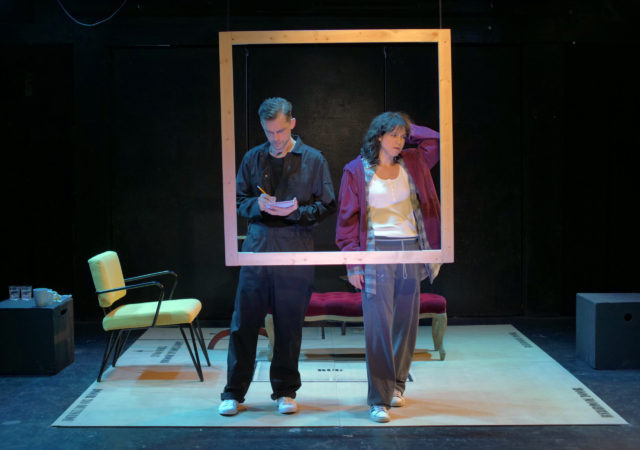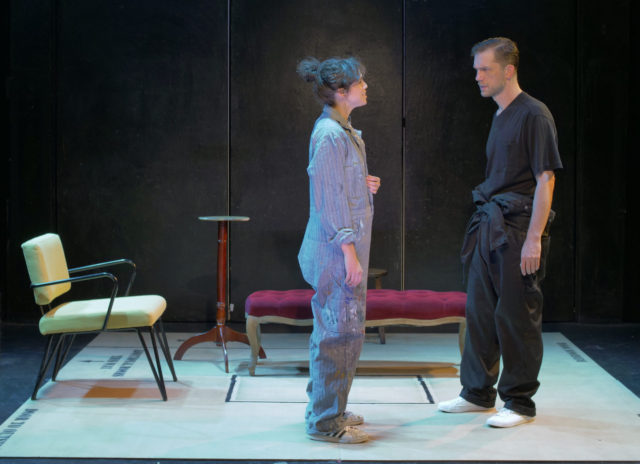
Adam Files and Alexandra Guerrero star in Jake Shore’s Hit the Wall (photo by Neil Ryan)
HIT THE WALL
The Kraine Theater
85 East Fourth Street between Second Ave. & Bowery
Thursday – Saturday through August 11, $25
www.frigid.nyc
During the pandemic lockdown, Rhode Island native Jake Shore wrote and directed (Adjust the Procedure, one of the best Zoom plays built around Zoom itself, consisting of a series of online meetings at a university attempting to deal with — or not deal with — a terrible tragedy. Presented by Spin Cycle and Shore’s JCS Theater Company, the prerecorded play enjoyed several extensions and was picked up by various festivals.
Shore’s first in-person play since theaters have reopened is Hit the Wall, a didactic seventy-minute, two-character drama about art and the audience continuing at the Kraine through August 11.
The show begins with famous forty-four-year-old graffiti artist Amir (Adam Files) and his protégé, twenty-five-year-old Rae (Alexandra “Allie” Guerrero), in his high-rise New York City apartment in 2010. For several minutes, they stand behind an empty picture frame hanging from the ceiling; it serves as a window to the outside world, an invisible canvas, and a reference to the Zoom boxes that were so prevalent during the height of the coronavirus crisis.
Rae tells Amir about a current project she’s failed to complete, a Madonna and Child on a wall in Crown Heights. She wants to go back and finish it, but Amir, who she compares to such graffiti legends as Banksy, Shepard Fairey, Lee Quiñones, and Claw Money, asserts that it would be a mistake, that she could be caught and sent to prison. “You’re succumbing to the rush and thrill of the chase, not the connection to your art,” he insists.
After some back and forth, Rae convinces Amir that she must finalize the work. He offers to help, but she refuses his support. The next morning she is excited, having executed the full piece in Brooklyn, and is now entertaining thoughts of hitting a wall in Times Square, despite the obvious danger. She tells him, “When I mention a wall, one of the first things you ask about is the visibility. The intention behind this being how many people can see it. How many sets of eyes. High visibility means a large audience, and then, in turn, more of a shot at influencing culture.” It’s as if Shore is comparing an off-off-Broadway play in Brooklyn — or a Zoom show — to a big-time production on the Great White Way.
While Rae desires the attention and wants to be a social media phenomenon, Amir is all about the art itself and its natural visibility to the right kind of people. He rails against capitalism and corporate greed, repeatedly claiming that sell-outs are rapists, thieves, and prostitutes. “Do you think that I would waste myself on the fuckers who visit and frequent Times Square?” he says. “That’s the point. Visibility is not just about the number of people you can reach, it’s about the quality of your audience.” A few moments later, Rae explains, “An empty theater has no audience,” another reference to the lockdown, when all theaters were empty and actors performing virtually had no idea who was out there watching them.
When Rae’s Madonna and Child suddenly and unexpectedly goes viral — perhaps not unlike what happened, to a lesser degree, with Adjust the Procedure — her relationship with Amir, and with her art, undergoes a rapid change.

Rae (Alexandra Guerrero) and Amir (Adam Files) discuss art and audiences in world premiere play at the Kraine (photo by Neil Ryan)
Directed by Timothy Haskell (Road House the Stage Play, Fatal Attraction: A Greek Tragedy, The Rise and Fall, Then Brief and Modest Rise Followed by a Relative Fall of . . . Jean Claude Van Damme . . .), Hit the Wall feels like an unfinished work in need of significant touch-ups. Even at only seventy minutes, it is repetitive as the two characters argue incessantly about the value of art and the need for it to be seen. Guerrero (At Least He Didn’t Die with Antlers on His Head) has the better, more well-rounded part, and she does a good job with it, capturing our attention and gaining our sympathies, while Files (Adjust the Procedure, Fragments) is held back by dialogue that sometimes sounds like he’s defending a dissertation — but only when you can hear the two actors, who have to compete with an aggressively loud air-conditioning unit.
Shore (The Devil Is on the Loose with an Axe in Marshalltown, Down the Mountain and Across the Stream) makes some interesting comparisons about mentors and protégés, parents and children — Rae has a strained relationship with her mother and ill father, so it’s not surprising that her signature piece is the idealized Madonna and Child, but the subplot grows overbearing.
The most compelling theme in the play is the exploration of the exchange between artist and audience as it relates specifically to live theater. At certain points Amir and Rae wonder if they themselves are performing for people sitting in seats, watching them.
“There is an eternal audience, Rae,” Amir says. “Imaginary?” Rae asks. Amir: “An eternal audience more real and present than any single person or group. . . . An audience on another plane. Like we’re in a play.” Rae: “Some otherworldly judgment? You speak clearly of God.” Amir: “Not God or gods.” Rae: “Then what?” Amir: “A group of viewers beyond our comprehension. . . .” Rae: “They are down there in the city, or up here so many stories high, but not seated in a dark theater in the caverns of your subconscious.”
No, we are seated in a dark theater, physical presences who have returned from two years of experiencing plays online, if at all, ready to be entertained, and challenged, no longer beyond comprehension. In a program note, Shore explains, “One reason I wanted to write a play like this is because graffiti artists want walls so badly. That’s sort of where it started.” Unfortunately, in his attempt to hit this wall, he misses.